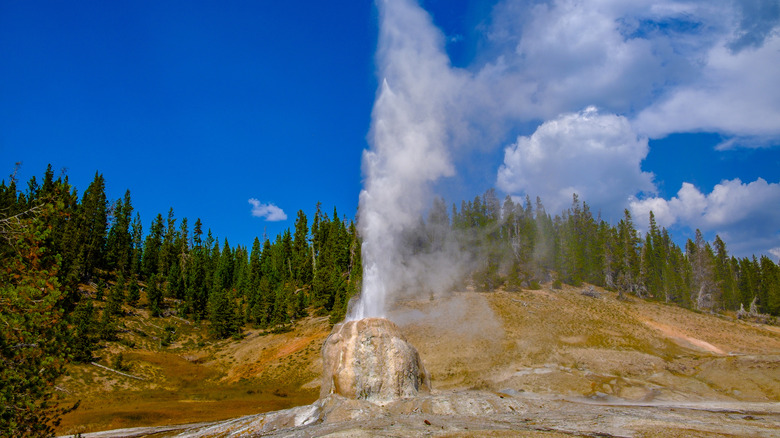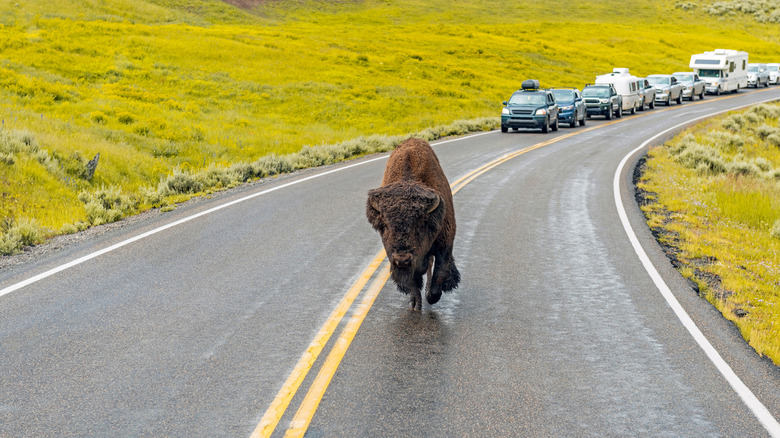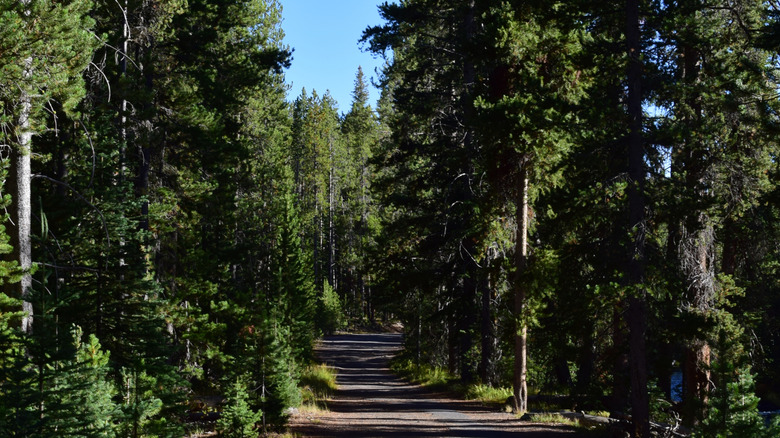Avoid The Crowds In Yellowstone National Park On This Quiet, Laidback Trail To Awe-Inspiring Geysers
An easy stroll or a leisurely pedal along the Firehole River can put visitors to Yellowstone National Park on the fringes of a dramatic geyser and away from the throngs of tourists who flock to this gorgeous Rocky Mountain destination every summer. In 2024, 4.7 million tourists descended upon the West's premiere national park, situated in the northwest corner of Wyoming (though it also includes a small sliver of eastern Idaho and a chunk of southwest Montana), so it might seem impossible to get away from the masses. But a 5.3-mile, out-and-back walk or pedal along a mostly paved path is usually enough to weed out casual tourists and allow visitors to take in Lone Star Geyser, an unheralded yet incredibly dramatic geyser that blasts a plume about 45 feet tall every three hours or so.
The modest hike or bike to the geyser starts at the Lone Star trailhead, just 3.5 miles south of Old Faithful off the Grand Loop Road. The trail is really an old, decommissioned service road into the park's backcountry, and most of it is paved. The trail is one of just a few wheelchair accessible paths in Yellowstone, so nearly everyone interested can experience the beauty of a remote geyser up close and personal. It's also close to other geothermal features in the park like Midway Geyser Basin, a vibrant geyser basin with a unique ecological environment.
You have to get there first!
To get the chance to see Lone Star Geyser blow its top, visitors must first get to Yellowstone National Park. The closest airport to Yellowstone's geyser country is in West Yellowstone, Montana, but it's a small, uber-regional airport with limited options. More affordable options for most visitors include flying into either Bozeman, Montana or Jackson, Wyoming, and renting a vehicle from an airport rental counter. Visitors arriving from Jackson will first drive through Grand Teton National Park (which is sometimes considered the best national park in America for people who hate hiking) before entering through Yellowstone's south entrance. From there, it's a 36-mile drive north to the Lone Star Trailhead. From Bozeman, motorists will drive north about an hour and 45 minutes to West Yellowstone, and then another 33 miles southeast to the trailhead.
The drive to the trailhead, regardless of which entrance visitors choose, is absolutely gorgeous. Pro tip from a Yellowstone veteran (I live in nearby Idaho Falls and visit the park often): don't rush, and don't go over the posted 45 mile-per-hour speed limit. The drive, particularly from the park's south entrance, is twisty and curvy, and drivers should pay attention to the road. Congestion is always possible due to one of the park's most coveted attractions: its wildlife. "Bear jams" and "bison jams" are common, but any critter wandering within sight of the road is enough for most far-flung tourists to slow down or even stop in the middle of their lane. Don't be part of the problem — when encountering wildlife that might be photo-worthy, pull completely off the road and use your hazard lights. This way, others who may wish to see other attractions can move along while the camera shutters click away for those who want wildlife shots.
Take your time once you're there
I once heard an old saying about Yellowstone tourists that goes something like this: the average tourist visiting the park could tie one end of a 100-foot rope to the bumper of their cars and the other end around their waists and never stretch the rope tight. Indeed, the average visitor never actually leaves the road. There are lots of ways to avoid national park crowds during peak season, but in Yellowstone, the best way is to find a trail and take a hike. This will leave the crowds behind, even at a well-developed trail like Lone Star. One other bonus about this walk to the spectacular geyser? The trail is as wide as a country lane. Even if visitors encounter more hikers or cyclists, it's easy to stay out of each others' way.
Because the walk to Lone Star Geyser is pretty easy — there are no big hills or switchbacks — it's a great option for families with active kids who don't mind walking or even riding bikes. Of course, the whole goal is to arrive at the geyser in time to see it go off. Keep in mind, the geyser isn't on a schedule. While it usually erupts every three hours or so, that's no guarantee. I've found that the best way to determine the next eruption is to ask folks walking back to the trailhead if they saw the geyser blow, and when. That way, visitors will know if they need to pick up the pace a bit so they can see the eruption, or if they can take their time and enjoy a leisurely stroll through the stunning Yellowstone landscape. Regardless, a visit to Lone Star Geyser to see one of the park's charismatic geothermal features is a great Yellowstone experience.


